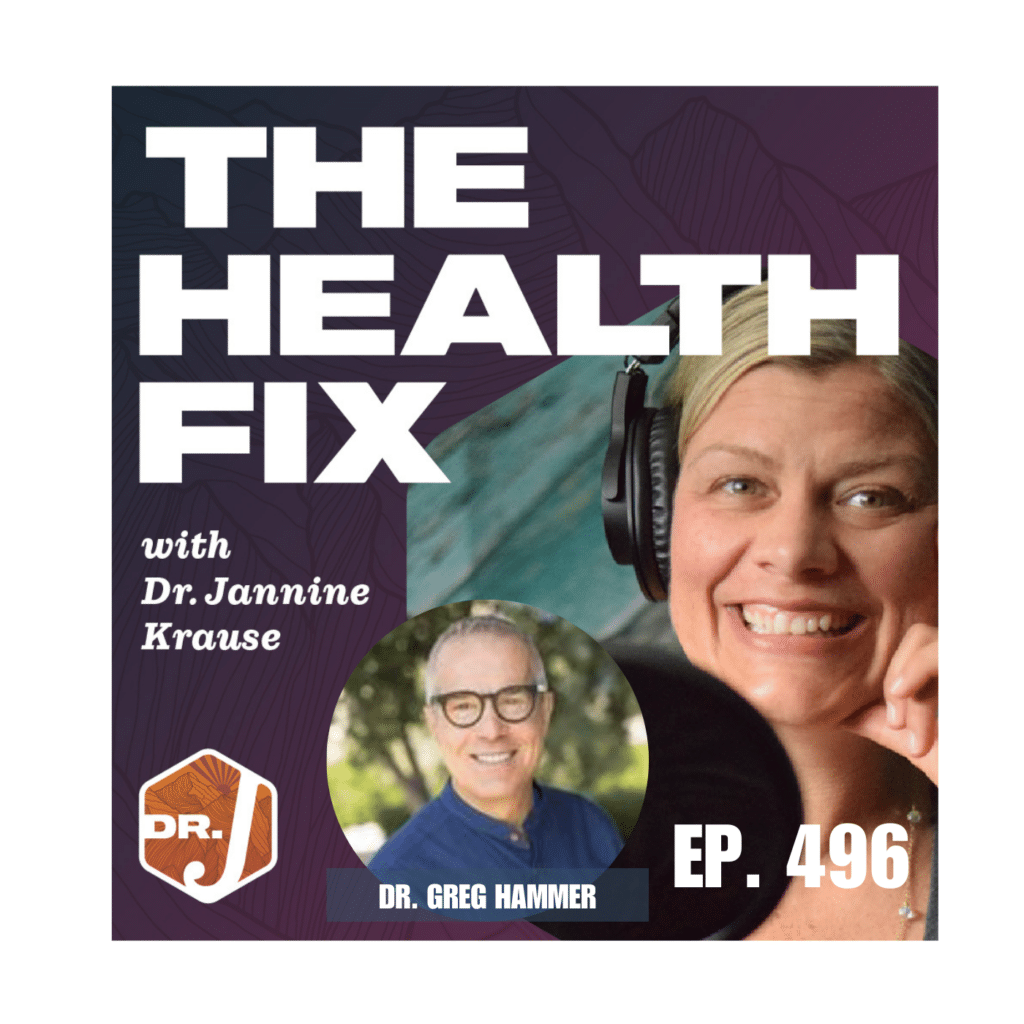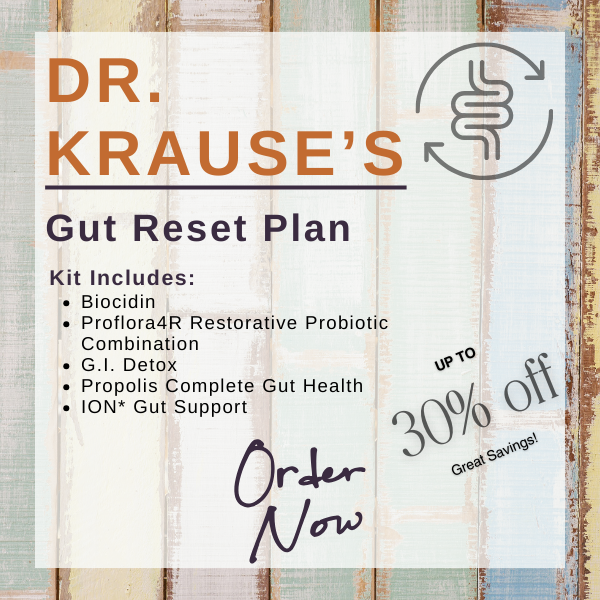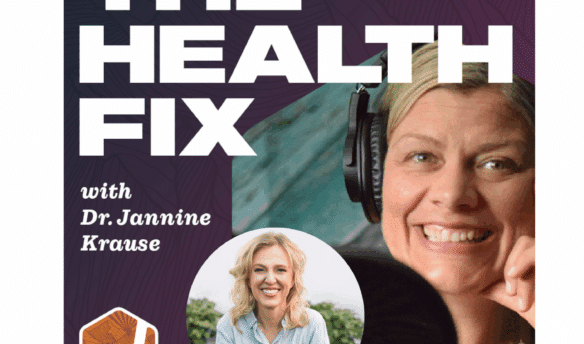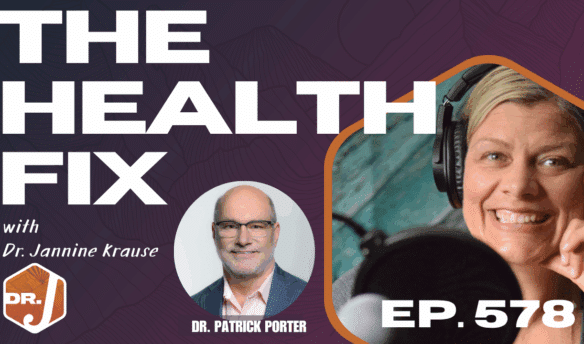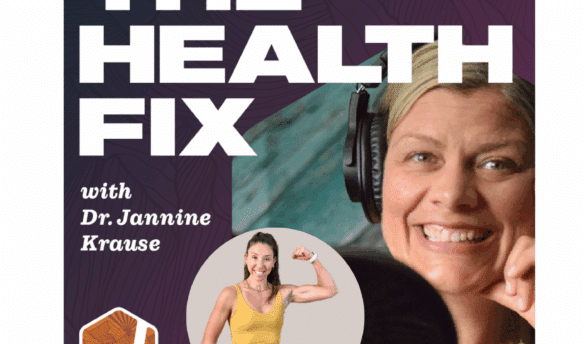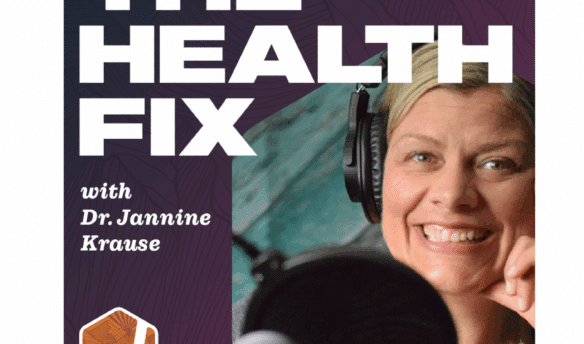82% of employees are at risk of burnout this year according to Fortune magazine. In 2023 physician burnout dropped from 48% to 62.8% in 2021, according to the American Medical Association. Perhaps the drop in burnout was due to increased education from docs like Dr. Greg Hammer educating physicians on resilience. Dr. Greg Hammer, MD is a recently retired professor in the Stanford University School of Medicine, pediatric intensive care physician, pediatric anesthesiologist, mindfulness expert, and the author of GAIN without Pain: The Happiness Handbook for Health Care Professionals. This proven path toward personal resilience can be implemented by anyone, anywhere, in just a few minutes a day. Increased resilience could save your practice, your patients, your marriage – or even your life. GAIN Without Pain is a four-step process toward happiness. GAIN is an acronym for Gratitude, Acceptance, Intention, and Non-judgment. In this episode of The Health Fix Podcast, Dr. Jannine Krause interviews Dr. Greg Hammer on his GAIN method and why it’s so successful for anyone to prevent burnout.
Dr. Krause’s Protocols
Instructions Included
Traveling soon? Looking to detox or reset your gut? Try one of Dr. Krause’s Fullscript plans.
What You’ll Learn In This Episode:
- What’s happening neurologically with certain thoughts
- Why building resilience to stress can prevent burnout
- How Dr. Hammer’s method helps you to manage stress
- The connection between lack of sleep and burnout

Resources From The Show:
- greghammermd.com
- GAIN without pain: The Happiness Handbook for Health Care Professionals
- Instagram @greghammermd
Podcast Transcript
2:00 – Dr. Greg Hammer’s background
6:49 – 400 US physicians commit suicide each year
8:10 – Stress response a.k.a fight or flight
14:58- Negativity bias
19:10 – Importance of sleep for brain function
21:21 – Mindfulness practice
22:19 – How to regain control if you your morning is full of negative thoughts
32:00 – Practicing non judgement – “I am”
35:46 – Natural ways of changing the brain. Plant medicines
37:22 – Are there any commonly used drugs in anesthesiology that have been researched for helping rewire the brain?
39:24 – Melatonin
45:05 – Focus on the fundamentals of physical well being
48:38 – Where you can find Dr. Greg Hammer online
[Intro] Welcome to The Health Fix Podcast where health junkies get their weekly fix of tips,
tools, and techniques to have limitless energy, sharp minds, and fit physics for life.
Hey, Health Junkies! On this episode of The Health Fix Podcast, I’m interviewing Dr. Greg Hammer.
He’s a recently retired professor in the Stanford University School of Medicine,
medicine, a pediatric intensive care physician, pediatric anesthesiologist, mindfulness expert,
and the author of Gain Without Pain, the happiness handbook for healthcare professionals.
Now this podcast isn’t just for healthcare professionals.
In fact, we’re going to be talking about the ins and outs of rewiring your brain and
how your thoughts do impact how you feel.
Not only that, we’re going to talk a little bit about how certain practices, such as
what Dr. Hammer talks about in his gain protocol or its gain method, its gratitude acceptance
intention and non-judgment, and how you can use those four things to promote overall
well-being and harmony between your mind and body.
While Dr. Hammer has established himself as a guiding light for numerous facisions facing
burn out in their respective fields, he has a lot of information that is relevant to
anyone out there.
Who’s facing burnout and feeling like they’ve got to figure something out.
So let’s introduce you to Dr. Greg Hammer.
JANNINE: Dr. Greg Hammer, welcome to The Health Fix podcast.
GREG: Great to be with you Jannine!
JANNINE: We decided to talk about resilience in the medical field.
really the concept of rewiring our brain when it comes to thoughts that happened in our personal and professional lives, but as a doc who who really did struggle for quite a few years with imposter syndrome and having a lot of crazy thoughts in my head, I’m really excited to to share your knowledge in your book as well.
So tell us what, what got you thinking about?
Hmm, maybe, maybe some of us doctors need to rewire our brains
a little bit or maybe society in general needs
to work on brain rewiring.
What, what was the impetus behind that?
GREG: I think Janine, it was a culmination of many threads
as is common, I think for most of us,
how do we end up where we are exactly?
I have been a long time student of advida or non-duality.
I’m a meditator. I go on spiritual retreat twice a year.
And so I’m very interested in spiritual well-being, and I always have been.
And of course, I’ve always been interested in physical well-being also,
since I’m a physician and have been for 35 or so years.
And, you know, I became a vegetarian when I was 18,
and decided I better learn about nutrition.
So you know, we’re talking about both being from the Chicago area and Wisconsin area.
And so I’m from outside of Chicago and I started my college career at Northwestern.
And I transferred to the University of Wisconsin rather in mixing your location and my former location together,
that went to Madison to study nutritional science
since that was one of the mechas.
And I’ve always been very interested in nutritional science
and physical fitness and mental and spiritual fitness.
So in 2011, there was a group convened at Stanford
to address burnout among physicians.
And that was called well-MD.
So I joined that initiative.
And the idea was to really identify
what the drivers of burnout are. And of course, that would point to the remedies. And as time
went on, I got to, I got asked to give a talk at a, a national meeting, actually, a hospital
administrators on burnout and wellness. So I did that. And then I got asked to give another
talk and another talk. And then I had some sabbatical time and decided to write a book about
it, which is called gain without pain, the gain being an acronym for what I think really
are the pillars of mental and therefore physical well-being as well, which are gratitude, acceptance,
intention, and non-judgment.
They form the acronym gain.
So that was kind of synthesized because I need acronyms, and you know, as you know,
in medicine and healthcare in general, we are loaded with acronyms.
And I think they do serve a purpose.
We may overdo it at times.
Anybody that would come and join us on rounds in the pediatric intensive care unit at Stanford
would probably not, unless they’re in healthcare, understand a word we said because it’s all
acronyms.
We speak, it sentences in acronyms.
So I thought, well, what are the fundamentals of wellness?
And three was not enough.
Five was more than I could remember.
So I came up with four gratitude, acceptance, intention, non-judgment, and gain.
So it’s been kind of a lifelong journey, I think, through the field of wellness, physical,
mental, spiritual.
And here we are, having this lovely conversation.
JANNINE: I’m sure glad that you did go through all of that.
It’s so funny that you dub is so hard for me.
I get confused too between University of Wisconsin
and University of Washington.
It is so tricky.
Speaking of acronyms, you stick into that circle
and boy, the brain goes in that case.
And I use that as an interesting segue
because our brains become easily confused
between what is threat and what is not threat.
And when I started to dive into this realm,
especially when I was probably at my peak of burnout
right as COVID started to hit, I really took a turn.
And in my brain, I started to have a lot of different thoughts
about how I shouldn’t be doing what I’m doing.
I didn’t have enough training.
I took a very to heart that naturopathic medicine training
is different than conventional training.
And I started to talk myself out of wanting to be a doctor.
And so I think looking at the stats
that you had on your website with each year,
400 US physicians commit suicide.
I mean, this is a lot considering how many doctors
there are out there.
And even that stat of 30% of new nursing graduates
leave the profession within two years.
to add to that as a acupuncturist
and naturopathic doctor after 10 years,
more than 75% of our graduating classes
are not even practicing as well.
So this is crazy stuff, huh?
GREG: Yes, I think burnout is a real thing in healthcare
and of course in every sector of life
because as you and I were discussing,
our brains are wired for survival
and not for happiness.
And so you also mentioned threat and not threat.
I like that because one of my favorite topics is stress
and the acute stress response, the physiology of stress.
And why did we evolve these changes,
these physiologic responses to actual threat
called the acute stress response
or the fight or flight response?
That really evolved for a good reason.
We were, say, go back 150,000 years.
We’re sitting in our cave, trying to keep the fire going
and keep our family warm and safe.
And it behooved us to consider that there might be a saber
tooth tiger looking outside the mouth of the cave.
We were faced with lots of actual threats.
And if we anticipated those, which meant we devote
a lot of time thinking of the future
and what might be the worst thing that could happen,
which we now call catastrophizing.
Back then it was just planning.
And so it behooved us to be able to,
at the drop of a hat,
or at the drop of a saber tooth tiger paw,
suddenly have an increase in adrenaline in our body,
which causes our heart to pump a lot more blood
to our muscles.
The blood flow gets redirected to where it’s needed
for either running or staying in fighting.
So there’s a lot of adrenaline circulating
our body for a good reason. There’s a lot of cortisol increasing in our bloodstream, which
also increases our blood sugar as does adrenaline, which therefore, combined with an increase
in flow from the heart, sends a lot of substrate, a lot of glucose to our muscles for optimal
functioning. So we have all these responses to actual threat called the acute stress response
or the fight or flight response.
And they evolve for a reason, but now fast forward 150,000 years to now,
this acute stress response is triggered mostly by our thoughts.
Right? I mean, for most of us, unfortunately not all of us, but for most of us,
especially here in the United States, we’re not faced with commonly faced with
actual threats. We don’t, it’s not a lot of predation in our world, in our environment,
that involves us as the prey.
And we’re not faced with a lot of foes that want to fight us.
So mostly the acute stress response is triggered
by thoughts of something stressful or an argument
or anxiety about a meeting with our boss.
So this is something that we deal with all the time.
And I think it’s okay to have the acute stress response
activated, the question is how quickly can we neutralize those changes, the increase in
adrenaline, cortisol, lots of other changes in our hormones, for example, before they become
chronic. And that’s called resilience. I mean, I think that is as good a definition for
me as of resilience as there is. It’s the ability to neutralize the acute stress response
when it is no longer adaptive and to prevent those physiologic changes from becoming chronic.
And when they do become chronic, we experience physical and mental fatigue and that’s what burnout is.
So it’s all about resilience in that case.
JANNINE: Which is something that I really wish we could
start teaching in preschool.
And how do we do it?
I don’t know, but I really wish this would start then
because being a doctor, there are certain stressors, right?
But just being on this earth in general.
And like you said, different people have different thoughts.
And it’s almost like we have no idea
until we had no idea until the last couple of years
people started talking about this concept that a lot of what we think is not even true.
You know, we’re making stuff up in our head and then we create beliefs out of it.
When you first learned that, did that blow your mind?
Were you like, what the heck is this even possible?
What was going through your head when you started to learn about all this stuff?
I’m curious.
[Advertisement] Hey, health junkies.
I wanted to tell you about my pal, Dr. Annamarie Frank supplement line that specifically targets
the needs of women from anxiety to depression to getting focused and balancing those hormones
as well as helping with sleep she’s got you covered. Plus she has T’s too.
This day and age it’s hard to know what supplement companies are up to when it comes to sourcing
and quality. That’s why I love to get to know company owners. Dr. Annamarie has created formulas
that combine what I would do if I owned a supplement and T company. So I wanted to tell you about them.
As a listener of the HealthFix podcast, you can get 10% off your order by using the code DRJKRAUSE
when you head to happywholeyou.com.
Now, say you’re driving or out on an adventure and you’re not going to remember where to find
this website. That’s okay. My favorite products are all on my website at doctorjkrausend.com.
Just click on shop and you’ll find everything I stand behind and use myself right there.
So let’s get back to the podcast.
GREG: Again, I think it’s been kind of a process, but yes, I realized
through, you know, a study of the brain and as an anesthesiologist and intensive care doctor,
I deal with the brain a lot. Certainly using drugs to manipulate what the brain is doing so that
people who are having surgery are not awake and conscious, for example. And on the other hand,
when the surgery is over, if appropriate, they regain consciousness in a relatively quick manner.
I think what’s happening in the brain is so fascinating and there’s all these
neural connections. I’m also interested in the developing brain because a hot topic in
pediatric anesthesia has been the effect of anesthetic drugs on the developing brain.
And what’s happening with all these neural connections that are being formed during fetal life,
late embryonic and fetal life, all these little neuron, the tips of these neurons are expanding
and growing and reaching out to connect with other neurons and forming all of these,
you know, many, many millions of connections. And the patterns of electric flow through these neurons
become rather fixed and established. And later in life, the more we think certain things,
we’re actually encouraging these connections to occur in these patterns. That’s what thoughts
are. It’s really just the pattern of neural activity and synapse formation and these circuits
form. And the more we think those thoughts, the more embedded these circuits become.
So really our thoughts beget our thoughts.
And we talked about how our brains are wired.
One way our brains are wired is to be rather negative.
It’s to think of the worst thing that can happen.
But beyond that, just we have a negativity bias.
We tend to remember negative thoughts and experiences and forget the positive ones.
And so when you consider that our negative thoughts in the context of these neural connections
becoming more well embedded, the more we think these thoughts, negativity gets negativity.
So I’ll give you an example.
We wake up in the morning and we get out of bed and what’s the first thing many of us think
about?
that’s not quite perfect with our body.
Maybe we didn’t sleep that well,
so we start to think about that.
Or maybe a part of our body is a little bit sore.
So let’s just say, our knee is,
we strained the ligament in our knee or what have you,
or maybe we’re just getting older
and we’re getting some osteopathyritis,
cartilage is wearing out.
So our knee’s bothering us.
We get up in the morning,
we’re thinking about our knee bothering us.
And we get out of bed and we’re sort of limping
a little bit to the commode and we’re thinking about, why do I have this pain in my knee and
I’m getting old and a whole series of these negative thoughts.
And low and behold, we start thinking those thoughts every morning when we get up.
And so what’s the remedy for that?
Well, I always go to the gain acronym.
And the first word in the gain series, if you will, is gratitude.
So instead of thinking about that one thing that’s bothering us in the morning, what if
we actually got up and redirected our thoughts toward gratitude.
So not to get overly medical and gross about it, but I think it’s not gross.
It’s actually quite beautiful.
We could wake up and be grateful.
Wow, all night, well, I was asleep.
My kidneys were filtering my blood.
They were taking these toxins out of my blood stream,
cleaning my blood, putting that toxic material into solution,
sending it down through these elegant little tubes
that are contracting and squeezing the fluid
down to our bladder.
And our bladder was kind enough for the most part
to store all that liquid with this toxic stuff in it
without waking us up to be emptied every 30 minutes.
Most of us at least, we make it up once or twice,
but not every 30 minutes.
And then we can actually get up and aim at the commode
and sitting, standing, however, we can get rid
of all that toxic stuff.
And so it’s a miracle.
I mean, that is really a miracle.
We can think of all kinds of physiologic things
in our body.
The way our heart is working, the way our brain
and lungs are coordinating so that we’re breathing
when we’re not conscious.
So many things for which to be grateful
that have been going on all night.
So let’s not focus on this one thing that’s bothering us.
Let’s pick something positive, something miraculous.
And I mean, let’s face it, the human body is full of miracles.
So this is a way of redirecting our thoughts
and so that we don’t have all these patterns of negativity
starting right in the beginning of our day and carrying on.
Let’s redirect those thoughts to something beautiful,
miraculous and something for which we’re grateful.
JANNINE: Absolutely.
I’ve never actually thought about the miracle
of what our body does overnight when I woke up.
I’m actually going to steal that because I do tend to,
you know, think about positive things and do a lot
of the grateful practice.
And I think a lot of people do.
But I don’t know how many people have actually
been to a training of gratefulness where they went
into the body’s miraculous function.
So guys, we got a new one there.
That’s good stuff.
That’s good stuff.
GREG: And there’s so many things, so many organ systems,
if you will, to think about,
think about all the stuff that your brain is doing.
Actually, most people don’t,
aren’t really aware of it.
They think sleep is just a passive activity,
but that’s not true.
Sleep is a very active activity.
Your brain is, just like your kidneys are cleaning your blood,
if you will, your brain is actually getting rid
a lot of junk in the cells in your brain. A lot of aging mitochondria, these proteins
that we’ve become a little bit familiar with in the news, tau protein for example, amyloid
protein, these things that are build up in excess in let’s say football players that
have repeated head injury and are associated with dementia and they’re also associated
with Alzheimer’s dementia.
The brain is actually getting rid of these proteins while we’re sleeping, but we have to
be in deep sleep.
It’s really important that we focus on our sleep hygiene.
Certainly, I don’t know about you, but when I was in medical training and even in practice,
sleep was something that we relegated to the middle burner because we were on call.
this idea that, well, we’ll sleep when we’re dead, kind of mentality. And resilience is being able
to function without sleep. And that is such a misguided way to think. You know, sleep is tremendously
important. So we could focus on what’s happening while we sleep. We can learn about it and be grateful
and redirect our thoughts to that. Like, wow, I slept last night, even if it wasn’t perfect. All
these great things were happening while I was asleep. So yes, we have so much for which to be grateful.
and we could start thinking along those lines
when we wake up in the morning.
And I’ve heard other people talk about this
in different contexts, this idea that we have these thought
patterns that begin with our first thoughts of the day
and then they just get more and more entrenched
as we go along.
And lo and behold, we’re quite negative.
And I think this is one of the main targets
of a practice, call it mindfulness practice
or whatever you like, that is targeting
reorientation of the way we think,
rewiring of our brain.
And I think this is one of the most exciting things
about healthcare in the broad sense
and really making ourselves healthier.
JANNINE: You know, I can’t probably even quantify it.
I’m sure you have the same thought of how many things could benefit from thinking positively.
Because I feel like you said, if we don’t get the day started off on a good, you know,
what, we will tend to go downwards unless, of course, we can pattern interrupt in the middle
of the day.
Is this where acceptance comes in?
In the four pillars, can you pattern interrupt?
If the gratitude didn’t quite set things up, or if someone skipped the gratitude, can
we intervene so that the day doesn’t go all the way down in negative spirals with acceptance?
GREG: Well, absolutely. The gratitude acceptance and tension non-judgment are so tightly interwoven.
It’s almost like they really set each other off. So, you know, the idea is to get up in the morning,
excuse me, open the blinds. This is a game practice. Okay. Do your morning hygiene thing.
be grateful about your kidney and bladder function among other things. But then just find a
comfortable place to sit. Hopefully, somewhere quiet in the house or outside if the weather is
supportive. Close our eyes and we focus on the breath. So we focus on slow, deep, intentional breathing.
Maybe in through our nostrils to a count of three, pausing to a count of three, and then
gradually letting the breath go to account of four through the nose or mouth.
And we settle into this slow deliberate breathing. And this is actually
doing something physiologic, which is activating our parasympathetic nervous system through the
vagus nerve and slowing our heart rate, reducing the amount of adrenaline and cortisol in our blood,
lowering our blood pressure, our heart rate, our blood sugar. So we settle into this breathing for
20 or 30 seconds. And then we go through a self-guided tour of that for which we’re grateful,
that we find uncomfortable or painful that we cannot change. That’s acceptance. Intention,
we focus on our current experience and then maybe transition to what is our intention for the moment
and for the day. And we finally transition to the end and gain, which is non-judgment. And we can
talk about that if you’d like, but there’s tools we can actually use to rewire our brain
to drop judgment, which is something that I think is so critical.
And again, we’re focused on the breath throughout this time.
And then we simply return our focus to the breath before we slowly open our eyes.
So you asked about acceptance.
And as the serenity prayer would have us understand, the world does not necessarily
comport to our apparent wants and needs.
And so we find ourselves in conflict with the world around us.
Other people, various things happening in the world, and even ourselves.
So we need to discern or we’re well served by discerning what of these uncomfortable or
even painful experiences we can change and what can we not change.
So many of us lost people we knew and loved during COVID.
I lost my son at the age of 29, eight years ago.
We’ve all lost loved ones.
That’s something that we can’t change and it’s a source of pain and discomfort to us.
So we have a choice.
We can resist ever thinking about those things and magnify our suffering.
The other thing we like besides acronyms and medicine and our formulas.
So there’s a formula in the my first book, suffering equals pain times resistance.
So the pain is there, the pain of loss.
If we resist it, our suffering increases, suffering equals pain times resistance.
acceptance can be considered the opposite of resistance. So through acceptance, we lower
our resistance and we decrease our suffering. So again, we need to discern, is this something
I can change? Well, if it’s the loss of a loved one, the answer is clearly no. And so let me
kind of sit with this. And during our gain meditation, while we’re focused on our slow, deep breath,
We also then picture this painful experience and we actually breathe it in. We actually bring it
closer to our body, open our chest, open our heart, bring this experience into our heart and nurture
it with our heart. Actually sit with it, breathe with it and relax our body as we do so.
And we learn that we can actually live with this.
And we can accept this.
And then we go on to the eye and gain, which is intention.
But this acceptance practice is very interconnected
with the other elements of gain.
So one reason we can accept things that are painful
is because we have so much richness,
so many wonderful things in our lives.
So when we think about, maybe we lost a loved one,
For me, I had two children.
I’m grateful for my daughter.
I have this beautiful 32-year-old daughter
that I spent half an hour on the phone with last night.
And I’m so grateful for that.
And I’m so grateful for the other people in my life
with whom I share love and friendship.
And so this is, again, it’s very interwoven with our ability
to accept things that aren’t perfect
or are maybe even very painful in our lives.
This is part of life.
Life has its ups and downs.
It’s pain and its joy.
And the sooner we actually adopt a practice
to understand and accept that, the better.
But again, the acceptance comes in part through gratitude,
through our intention,
and through our ability to drop the judgments
which magnify our suffering as well.
JANNINE: That’s quite thorough.
When you think of it, you’ve covered all the aspects and different things that will
come up, which is nice because it compacts things for folks so that the practice is easier
to be able to carry out, at least as how I see it.
Yeah, let’s talk a little bit about judgment a little bit because I do think that that
is one of the biggest sticking points, especially in a professional setting.
do tend to self-judge a lot, but also in anyone who’s not, you know, say in a professional
setting, it’s easy to judge your body kind of like you’re saying, we think about like,
why am I so creaky? You know, why can’t I lose weight? You know, whatever it may be. So,
I’ll let you kind of explain a little bit more on working on non-judgmental practices.
GREG: Sure. Well, first I think we have to distinguish between discerning and judging, right? So it’s
It’s important to discern.
So an example.
I’ve got an hour in the middle of the day to get together with a friend.
I can either get together with Sam, who’s kind of a downer.
He’s complaining a lot.
He’s very judgmental.
He tends to gossip about people that we know.
I don’t feel that great at the end of an hour with Sam.
Although, you know, Sam is, I consider him like a brother.
I can spend that hour with Jim, who’s upbeat, pragmatic, present, mindful.
He’s like, I would like to consider myself.
And we have great conversations.
We talk about spirituality.
We talk about many things.
So I’m going to discern that I would rather spend my hour with Jim because it’s a wonderful
experience.
And I care about them both, but I don’t have to judge either one of them.
I don’t have to judge that Sam is bad and Jim is good.
There is no good and bad about us, about people.
We’re not really, this is my view, not everybody will agree with us, we’re not infused with
the qualities of goodness or badness.
We simply are the human that we are.
And since our minds are wired to be judgmental and they’re also wired to be negative, most
of our judgments are negative.
When we judge others and we judge the world around us, and as you suggested, most harshly
for sure ourselves, we’re negative in our judgments and we’re very hard on others, the world,
and mostly ourselves.
So can we change this?
Again, these judgments are simply, if you want to get neurophysiologic about it, they
are patterns of nerves firing and communicating with other nerves in different parts of
our brain.
They become entrenched.
These patterns, these judgments, these neural connections, fortify one another every time
we judge.
we have a practice where we drop the judgment. And so in the game practice, we’ve been sitting
now for three or four minutes, breathing deeply, going through gratitude, acceptance, intention,
we get to non-judgment. So here’s an example of what we might spend 45 seconds doing
during our five-minute game practice, or three or four-minute game practice, when we get to the
end and gain during this sort of self-guided contemplation. We, as we breathe deeply through our
nose and pause and let the breath go through our nose and mouth slowly, we picture an image of the
earth apparently suspended in space, one of these beautiful NASA images of the earth. And it’s a
lovely planet and it’s also neither good nor bad. It’s just a planet. It doesn’t have the qualities
of goodness or badness. It’s just a, you know, it’s a beautiful orb. There’s a lot going on on
the surface. But the planet is neither good nor bad. It’s just a planet. And then we transition to
thinking of ourselves in the same way. I am just the person that I am. I am neither good nor bad.
I’m just a human being. I’m neither good nor bad. I just am the person that I am. I simply am.
I am. And this is connected to this slow, deep, deliberate breathing. And we sit with this idea for
even just 15 seconds. And then we return our focus strictly to the breath. And, you know,
we can picture a mountain, a tree, you know, an image of ourselves ultimately. But we can teach
ourselves and establish these neural patterns associated with letting go of judgment. Because
judgment really is like a thin veil that we are looking through when we’re exercising
these thoughts. We’re not seeing things as they truly are. We’re coloring them, if you
will, with our own biases, right? Our own internal ways of thinking. So when I think
about another person, you know, I judge them according to my own set of biases. And if
I drop those judgments, I just see them as a person. You know, there can be a bit of a
positive cue to it. But really, they’re neither good nor bad. And I feel that way even
about people who clearly do harm to others. You can trace that back to their parenting
and then why was their parenting like that? It was because of their parents parenting
and you know, you can just sort of keep going back and back and trying to explain why somebody is the way they are, why I am the way I am.
And ultimately, you may just find rest in the notion that I am just that I am, that there doesn’t have to be goodness or badness to it.
And so, you know, this is a way of practicing non-judgment and we do need to practice it because
I think that our brains are wired to be judgmental and with our negativity bias, we’re often
negative in our judgments.
And the good news is our brains have this wonderful quality called neuroplasticity and we can
actually change the way we think.
And so that’s what the game practice is really all about.
JANNINE: It’s an incredible concept, I think still to this day, for many of us who weren’t kind
of brought up in the realm that what you can change your brain.
Like Norman Doidge, I believe, was the book The Brain That Changed Itself or something
like that.
If I’m remembering the book correctly, that was my first foray into, I’m reading this
going, what?
I can change my, you know, and you know, here we are.
Did you read that one?
Did you?
GREG: No I haven’t read that one. I’ve read some other books about changing the way you think, changing
your mind, et cetera. And actually, it has become kind of a hot topic. So there are a number
of books written about it. There’s a lot online about how we can rewire our brains and
change the way we think. And there’s a lot of research going on with drugs and natural
substances and you’re a naturopath. I don’t know how you feel about
natural substances that might help people change their minds. Psychedelic drugs,
psilocybin being one. There’s a lot of very legitimate research going on about how we can actually
rather, you know, quickly change the way the brain is wired in certain ways.
with guided psychedelic experiences, for example.
So it’s just, you know, really as you suggested,
such a fascinating topic.
JANNINE: It is. And definitely with the psychedelics, I’m intrigued, you know,
a lot of the plant medicines and intriguing, a lot of even just anything
that can help folks with the process.
Because I think you see this as, I’m going to rewire my brain.
Oh my gosh, that’s eight pounds of what is going on in there, you know,
and depending on where someone’s been in life, the different things they’ve been through,
they might be thinking like, Oh, I’m a hot mess. How am I going to do this? But,
you know, looking at your book, it’s a very simple straightforward with the gain process. It’s very
easy to to understand, Okay, if I do this, I can work on changing my complete way of thought.
Now, I’m curious because you’re an anesthesiologist and background of putting people to a nice
sleep while they have surgery or different procedures. Have you uncovered any research of any of
the things that would be commonly used for anesthesiology that has been researched
or helping with brain changing and brain rewiring? Anything in there?
GREG: Well, I don’t know about changing the brain during anesthesia while there’s a surgical procedure
going on, but you know, certainly the drugs that are used,
ketamine is one. I happened to have used a lot of ketamine in my career for
variety of reasons. It has some wonderful properties
as an anesthetic. And ketamine is one drug that’s being used to treat people with
addiction or PTSD or a number of other
conditions where rewiring of the brain is rather imperative.
So that would be an example of a drug that does have anesthetic, it’s very important
anesthetic properties that can be used therapeutically in a different context to help people with
depression and other mental disorders, psychological disorders.
But I just think that anesthesiology is such a fascinating field for so many reasons,
But one of them is just how these drugs affect the way that the brain is functioning.
And somebody who’s under anesthesia is not really asleep.
If you look at their brainwave patterns, for example, they’re not the same as what you
see if you look at brainwave patterns in somebody who’s naturally asleep, right?
And the drugs that people take to help them sleep actually interfere with these normal electrical
processes and deprive the individual of some of the restorative benefits of real sleep.
So that’s why many of the sleep drugs, especially the ones that are not probably in your domain,
naturally occurring substances, are really to be discouraged other than for very occasional
use.
One exception might be melatonin, which does seem to support physiologic sleep.
And actually we produce less melatonin as we age, and that may well be one reason why
people don’t sleep as well when they get older.
I just wrote an article that I was asked to write on the summer blues.
There’s a lot of talk about the winter blues, but there’s also the same kind of phenomenon
that occurs much less frequently in people in the summer.
And one reason that people may get sad in the summer, and there are several, but one
of those reasons might be related to melatonin because the long days, the long periods of sunlight
suppress melatonin secretion just as the opposite may happen in the winter.
And you know that melatonin is a really magical substance.
It’s not just related to sleep, but other physiologic important brain functions.
So anyway, be interested in your perspective on natural, naturally occurring substances
that may provide not only sleep, but also perhaps the setting for people to begin to
rewire their brains with the use of natural, redic substances.
I don’t know if you have any wisdom on that.
JANNINE: You know, I’ve tried a different, a lot of different things in the neutropic realm.
So things from Bacopa, Maneri, to Hupersing A, to even going into some of the adaptogenic
herbs to help rewire the brain.
Even L-theanine in some combinations will help along with ashwaganda, holy basil.
It seems that what I’ve found, and this is only my own experiments in my own world of
patients, is that if I can calm the brain down enough, we can, and slow the brain down
enough, we can get some change.
Or if we can get enough focus, we can get some change.
And so those would be some of the most common ones.
I’m laughing at myself about asking about ketamine.
I’m like, of course, ketamine is one of the aesthetics.
I gotta go back and laugh at myself.
But yes, ketamine, I mean, I do send people for ketamine therapies as well, but back to
natural substances I can work with.
Yeah, L-theanine and holy basil tend to be a very good combination to help people, at
least what I’ve seen in my world.
Have you seen?
GREG: There’s the interesting data on psilocybin taken in very small doses or microdosing doses
that are not associated with any psychic changes that the person experiences as they would
with a macrodosis psilocybin, but just taking very small doses.
I look forward to more science on these things because right now, I’ve done some research
on psilocybin and just the literature research and it’s almost all anecdotal for microdosing.
What’s the best way to do it?
Well, three times a week, blah, blah, blah,
or a week on, a week off.
And it’s really just what people have experimented
with themselves.
And then there’s some survey science, if you will,
where people who have microdostor interviewed.
But I think this is rewiring the brain,
primarily through non-medicinal practice,
as we’ve been discussing.
But also, I think there is a role for,
naturally occurring, ideally, substances,
and this is kind of a burgeoning area of research,
and I think it’s just so fascinating.
Well, we were talking a Jannine about books
that have been written about rewiring our brains,
and I have read a few, I think Michael Pond’s book,
How to Change Your Mind is My Favorite.
And one thing I really like about it is it’s very personal.
So he describes his own personal journey,
And he’s a rather bold guy who’s open to trying
a number of things.
And so he describes that.
So anyway, there is a lot written about
rewiring our brain these days.
And so I’m happy about that.
And I look forward to a lot of research coming out
of academic institutions on the use of psilocybin
and other drugs and how they may facilitate
and expedite the rewiring process for the better.
JANNINE: Yeah, I’m definitely looking forward to that because right now the situation in which
when someone comes to me and wants to do that, we’ve got to find, you know, someone has
been trained, someone that’s, you know, has been through some, some level of authenticity
versus like there’s this guy around the corner. He’s got this good stuff, you know.
I swear it’s going to change your mind. It’s, it’s funny, you know, I somewhat feel like
a backdoor drug dealer when I’m working on these kind of things.
But the truth is that a lot of people really do have some pretty profound changes when
they work with someone who can guide them and has a process.
And I think that’s what’s really nice about your book.
You know, if someone is going to, because we can’t really stop anybody doing their micro
dosing on their own, but if they’re going to do it, at least get a book to work with so
that you got a baseline, their process versus letting your brain try to figure out what
that’s going to do on its own, because that doesn’t usually end well, at least what I’ve
seen with my patients.
GREG: think even people, if they’re taking a naturopathic substance or what have you, when we do something
that we believe is good for us, and we do things that we know are good for us, that gets
us sort of begins to do this reorientation process, this rewiring process. So, you know,
that’s why I say when people have mild sadness in the winter or summer, you know, it’s called
seasonal affective disorder. I think affective disorder implies something a little more serious
and people who are having the inability to function should get professional help. But
If it’s just sort of mild depression, mild anxiety, for example, when we bring our focus
back to the fundamentals of physical and mental well-being and physical well-being, really
the three fundamentals are sleep, exercise, and nutrition.
So when we’re experiencing these things, this depression, being a little bit off the
rail, go back to the fundamentals of physical well-being.
on your sleep hygiene. Go to bed and get up at the same time every day if you can.
Darken the room. Make the room cool if you can. Avoid screens,
proximate to the time of going to sleep. Caffeine has a very long half-life.
That cup of coffee you have in the afternoon at one or two o’clock is like having half a
cup at six or seven or eight o’clock in the evening, and that would keep me awake.
So I stopped my afternoon cup of coffee. There’s a number of fundamentals, and then of course,
Exercise, you know, some is better than none.
Go out and do a power walk around the block every hour or two while you’re working at home.
What have you? And then nutrition, you know, moving to a more plant-based diet,
avoiding refined and sugary foods, etc. So I think when we start to do these things that are good for us,
we are getting on track for doing more that’s good for us. Again, this is part of rewiring
the brain. It’s our behaviors, not just our thoughts, but it’s what we’re doing with our bodies.
The exercise that we’re doing, the focus on sleep hygiene. When we start to focus on good health,
it’s these neural connections related to thinking good thoughts begin to get entrenched
and predominant. So there’s a lot of doors that are open to us.
naturopathic medicine for sure.
Sleep, exercise, nutrition, a daily mindfulness practice.
All these things will help us begin to get on a positive path and help us
rewire the brain in the right way.
JANNINE: Absolutely. Absolutely. I think it’s definitely still keeping in mind that we need a
comprehensive or holistic approach. It’s not just that one magic bullet.
always want to highlight that. We need you know to find a complete mix and definitely looking
into your book, Gain Without Pain is definitely one of the places I’d like folks to start if they’re
starting the process or even if they’re going to continue the process. I think it’s worth a look. So
Dr. Greg, let’s tell folks where they can find you online, get to know more about you and dive
a little bit more into you and your story.
GREG: Well, they could go to my website, GreghammerMD.com, g-r-e-g-h-a-m-m-e-r-m-d.com.
There’s a lot of information there, a lot of media.
And I’m in the process of really upgrading my website and social media to something
that I have never really been very involved with.
But now that I’m retired from my medical practice, I have a little more time.
And teaching is still extremely important to me.
So GreghammerMD.com is a good place to go.
JANNINE: Perfect.
Yeah, the social media.
Teaching is a better place to put your effort in terms of my personal opinion.
But social media is entertaining.
Let’s just say that.
GREG: Well, I think for me, it’s just a matter of, you know, as I’ve been advised and come
to realize just getting eyeballs to your website and that’s really where I’d like people to go.
I’m hoping to offer as much information there as I can.
JANNINE: Makes sense. Now, great stuff. I really like the concept, the game concept, and I can see it being
used really well for folks within a paradigm of rewiring obviously as the goal, but also as part
part of a holistic approach to help uplevel their life in general.
So, love the stuff.
Dr. Gregg, thank you for coming on,
ensuring all of your wisdom.
I appreciate it.
GREG: It’s my pleasure, Janine.
Love having a conversation with you.
[Outro] Hey fellow health junkie.
Thanks for listening to The Health Fix Podcast.
If you enjoyed tuning in, please help support me
to get the word out about the podcast.
Subscribe, rate, and review, and just get that word out.
makes again for listening.
(upbeat music)
